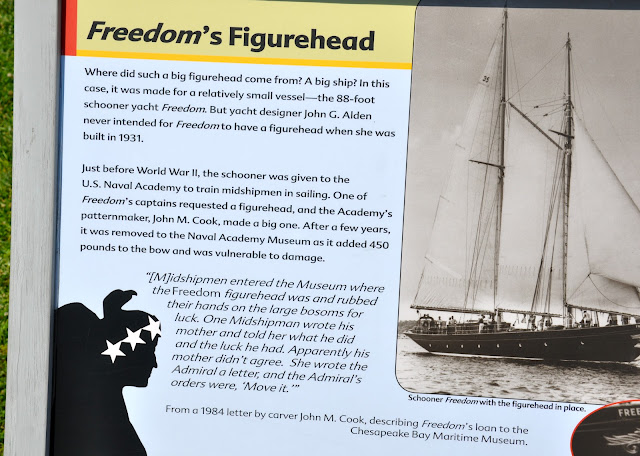This is the Officer's Club at Aberdeen. The foreground left is the building where we stayed.
Replica of the Lazzaretto Point Lighthouse in Baltimore Harbor:
Fort McHenry. Francis Scott Key was on a ship watching the bombardment of this fort by British warships during the War of 1812 when he was moved to write the Star Spangled Banner. At the end of the introductory movie, a screen lifts as our national anthem plays and a flag is sighted flying over the fort. There was a class of 3rd graders in the visitor center with us. As the music began first one, then 2 or 3 more, then 5 or 6 stood until the whole class was standing and singing, with their hands over their hearts, as the flag was revealed. We were impressed and moved.
Baltimore inner harbor, Chesapeake Light Ship, submarine Torsk and the very modern and large buildings house the National Aquarium. It looks as if it would take at least a whole day to do the aquarium justice, so we'll save it for our next visit.
The USS Constellation is the last sail-only warship designed and built by the U.S. Navy. When we last visited in 1994, it was in rough shape. We were glad to see her looking so sharp:
This wonderful sign was in front of Barnes & Noble:
Coast Guard Cutter Taney, the last US warship afloat today that was in Pearl Harbor on December 7, 1941.
This is 7 Foot Knoll Light, one of only 4 remaining Chesapeake Bay screwpile lights, and now open to visitors in Baltimore. The stories of moving the 3 lights (one is still active) to their museum sites are all different. This one was carried here by a crane, as illustrated in the picture below. The one at Solomons Island was moved into place by a bridge building company that had been cited for dumping unneeeded cement into the water. There were intimations that the fines could go away if the lighthouse was moved and it was.
.
Edgar Allen Poe's grave:
Back on the boat: Once a month routine maintenance includes cleaning the engine, generator and air conditioner sea strainers to keep unwanted gunk from going through. The ice maker and refrigerator also have to be defrosted (makes us appreciate the frost-free models we all have in our homes!), and the sump that drains the shower and air conditioners cleaned. This is the engine compartment:
We left Patuxent Naval Air Station Sunday, June 3rd. These cliffs are about 30 miles long and contain many fossils.
Cove Point Lighthouse. The tanks in the background are part of Dominion Point LNG Terminal,
one of our country's biggest liquified natural gas facilities:
Across the bay to the Eastern Shore, we docked in St. Michaels.
The Chesapeake Bay Maritime Museum here is the biggest and most informative maritime museum we've visited. This is a replica of the boat John Smith used to explore the Chesapeake. In 2007, 12 people spent 121 days traveling 1700 miles on this boat, repeating Smith's journey.
We'll let the sign describe this one.
There was an extensive boat building, repair and restoration facility:
The Hooper Strait Lighthouse is the 3rd screwpile lighthouse at a museum. It was cut apart at the roof line to be moved here.
Something that didn't have to be considered for Great Lakes lighthouses, even those far from land, was how to get fresh water. Here, large cisterns were placed throughout the lighthouses and rain water was collected from the roof. When it rained, the keepers would let the first rain wash dirt off the roof, then they would open valves to fill the cisterns.
A view from the lighthouse:
Another of their restored boats:
This 50's era powerboat had a very familiar cabin design-just like our 1985 25 foot Cruisers. The side dinette (we used to take the table down, stuff a washcloth in the table-leg hole, and make a crib for baby Benjer), the bunk beds, the big windows in the front of the cabin. Someone from Cruisers had to have seen this boat. Wonder if cabin designs can be copyrighted.
A familiar feeling:
This gorgeous boat belonged to the same family (2 generations) for almost 75 years. There must be a lot of good memories.

John is pulling up an eel trap,
but there's only a couple of small fish and an unhappy crab.
How many oysters can he capture?
Hmmm. Don't think we'd make a living at it.
Oyster dredges that were used on boats:
Yep, you can't just pull off an exit when you're tired!


































No comments:
Post a Comment